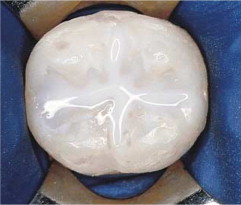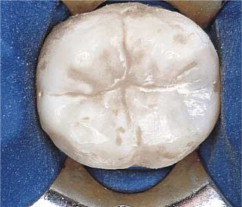Sealants are another line of defense against cavities, in addition to brushing and flossing. On the chewing surface of our molar teeth there are tiny grooves and pits, that are so small they can’t even be cleaned with a toothbrush bristle. These small grooves are an easy hiding place for bacteria to collect and for decay to begin.
We use sealants to cover these little grooves and stop the bacteria from infiltrating. When applied correctly sealants can prevent 80% of cavities for up to 2 years and continue to prevent 50% of cavities for up to 4 years. Sealants are usually indicated in childhood, first when the six year molars erupt and then when the 12 year molars erupt. Sealing these permanent molars soon after eruption can help ensure they stay cavity free for a longer period of time. As long as the teeth are able to be kept dry during the procedure, getting sealants is a painless and typically quick process. The process for sealants is as follows:
- Etch teeth, this cleans and roughens the tooth surface to prepare for a sealant.
- Rinse & dry teeth thoroughly
- Apply sealant material and spread evenly through pits and grooves
- Cure (harden) with a UV light for 30 seconds
- Done! That’s it, quick and pain free!
Sealants are usually covered up to a certain age limit by many insurance companies. We can help you determine if you or your child has sealant coverage. Sealants will typically last for several years before they may need to be reapplied. You may want to consider paying out of pocket to have them reapplied, even if you are past the age limit for coverage. As they say an ounce of prevention is worth a pound of cure! Sealants, even without insurance coverage, are typically still cheaper than the patient portion for a filling if decay begins.
Your dentist will evaluate if sealants are recommended for you at your regular dental visits! As always, let us know if you have any concerns regarding the sealants process or questions about your possible insurance coverage.
References
Mouth Healthy by ADA
https://www.mouthhealthy.org/en/az-topics/s/sealants
CDC
https://www.cdc.gov/oralhealth/dental_sealant_program/sealants-FAQ.htm


